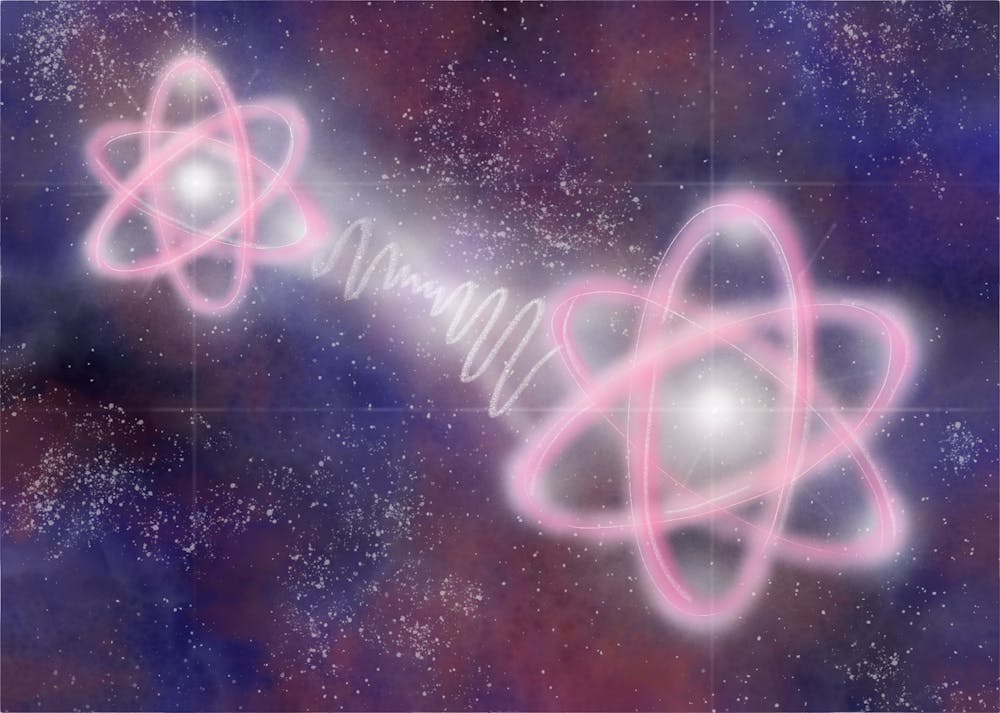ASU is rapidly becoming a hub for groundbreaking research in the field of attosecond physics, thanks to advancements in laser technology and innovative experimental methods.
Attosecond physics describes the properties and behaviors of particles such as electrons at incredibly small time scales of at least one-quintillionth of a second.
The journey of ASU in attosecond physics is marked by unique strides in laser technology.
"This is an entirely new type of chemistry, and it's just getting started … on this time scale, all nuclear motion is completely frozen," Scott Sayres, assistant professor at the School of Molecular Sciences, said. "That means that we're exploring how the electrons move."
The ability to observe frozen nuclear motion introduces an entirely new perspective in understanding chemical reactions and electron dynamics.
"Laser technology has really skyrocketed and improved very quickly over the past few decades," Sayres said. "The advent of the femtosecond laser was really important (and) won the Nobel Prize in 1999. 24 years later, now we have a Nobel Prize for 1,000 times shorter (pulses)."
This breakthrough has enabled researchers to access shorter laser pulses than ever before, opening new avenues in the study of atomic and molecular dynamics.
At ASU, the CXFEL laser, located in the Biodesign Institute, will serve as the primary tool for future breakthroughs in attosecond physics. While the laser primarily operates in femtoseconds, the team believes that the attosecond level is possible with the instrument.
"Personally, I'm not a builder of that instrument, but I am going be a user," said Sayres. "That instrument is going to enable really exciting new chemistry and physics to be understood."
The use of this sophisticated tool is expected to unravel complex physical and chemical phenomena that were previously inaccessible.
"The way the electron nanobunches are produced in the CXFEL accelerator allows us to make attosecond bursts of X-rays," said Arvinder Sandhu, professor of physics and optical sciences at the University of Arizona.
The main barrier to achieving attosecond speeds is stability; once the laser's beam can steadily achieve femtosecond pulses, it can be adjusted down further.
One application of this technology is measuring how electrons change sharply between energy levels, which is often referred to as the absorption edges of the material.
"What we want to do is that, it all depends on matching the energy scales and the time scales," Sandhu said. "We want to use these X-rays, these attosecond X-ray bursts, to monitor the absorption at the edges (in materials like) carbon, nitrogen (and) oxygen."
Additionally, ASU is expanding its research facilities to accommodate diverse experimental setups.
"In my lab, we do mostly gas phase work, which means we expand a molecule into an atmosphere where it's completely isolated from all other molecules," Sayres said. "We're studying the raw molecule isolated by itself in the gas phase."
This approach allows for the study of molecules without interference of other gas compounds and elements, providing clearer insights into molecular behavior.
Another significant aspect of ASU's research involves understanding how ionization probabilities of molecules change over time. These studies are crucial in decoding the electron movement and interactions within atoms and molecules.
"We study, for example, how the ionization probability of (a) molecule changes over time ... we can learn information about where the electron has moved to during the time period that we're interested in," said Sayres.
ASU is not alone in their efforts to progress the field; the collaborative nature of the project invites scientific minds from across the country to participate.
"We do have about 10 people from different places who are going be working as a part of the AMO (Atomic, Molecular and Optical Physics field)," said Sandhu.
This collaborative effort brings together interdisciplinary experts, enhancing the depth and breadth of the research.
ASU's advancements in attosecond physics mark a significant leap in scientific exploration, underpinned by its state-of-the-art technology, collaborative efforts and a dedicated team of researchers. This research is not just a series of experiments but a pathway to understanding the fundamental principles of the universe.
Edited by River Graziano, Sadie Buggle and Caera Learmonth.
Reach the reporter at dmanatou@asu.edu.
Like The State Press on Facebook and follow @statepress on X.
Dimitra is a junior studying biomedical engineering and physics. This is her second semester with The State Press. She has also worked as a research assistant in Kirian Lab.




